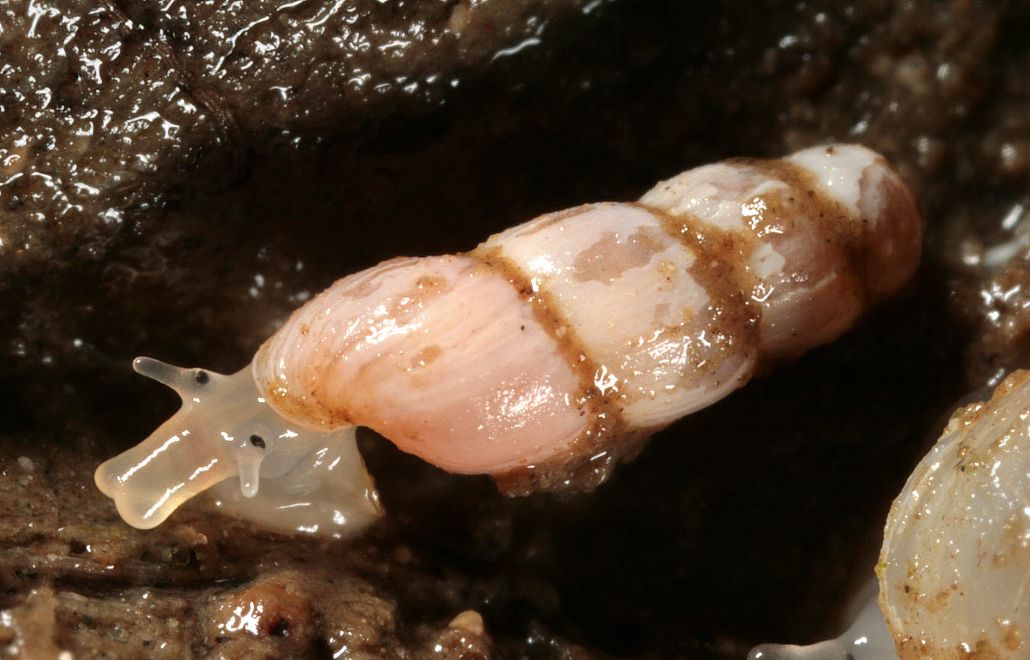Invasion History
First Non-native North American Tidal Record: 1880First Non-native West Coast Tidal Record:
First Non-native East/Gulf Coast Tidal Record: 1880
General Invasion History:
Truncatella subcylindrica is a very small high intertidal-subtidal snail, found from England and Ireland, south to Morocco, and east to the Mediterranean and Black Seas. It inhabits wrack-lines, muddy shores and shoreline vegetation, and is often exposed to the air in moist habitats (Fretter and Graham 1962; MarLin 2004). Truncatella subcylindrica was first reported in Azores in 1980 (Cardigos et al. 2006). In 1880, A. E. Verrill found an apparently established population of this snail in Newport Harbor, Rhode Island (RI) (Verrill 1880b).
North American Invasion History:
Invasion History on the East Coast:
In July and August 1880, Verrill found numerous specimens of young and adult T. subcylindrica 'among the decaying seaweed at the high-water mark in docks at Newport R.I.', together with other strandline fauna, including the snails Myosotella myosotis, Assiminea succinea, Ligia sp., and Orchestia sp. (Verrill 1880b). There are no further records of this snail from North America. Dry ballast was the most likely mode of introduction.
Invasion History Elsewhere in the World:
Truncatella subcylindrica was first found in the Azores in 1980 on Terceira Island, and found on Graciosa Island in 1989 (Cardigos et al. 2006). It could have been introduce many years previous with dry ballast, or later with seaweed on cargo or fishing gear stored on the shoreline.
Description
Juvenile shells of Truncatella subcylindrica are conical, with 5-6 whorls, but as the shell grows, the upper whorls are lost, resulting in roughly cylindrical shells with about 3-4 whorls. The whorls are sometimes ribbed. The aperture is oblique and the shell lacks an umbilicus. Adult shells are about 5 mm long. Juvenile shells can be longer, because they have not yet lost the upper whorls. The shells are pale-yellow to light brown. The common name is derived by its peculiar form of locomotion, in which it reaches for the ground and attaches to it with its snout, and then arches its foot and attaches it just behind the snout, then repeating the process in an inchworm-like fashion. Description from: Fretter and Graham 1962 and MarLin 2014.
Taxonomy
Taxonomic Tree
| Kingdom: | Animalia | |
| Phylum: | Mollusca | |
| Class: | Gastropoda | |
| Order: | Neotaenioglossa | |
| Family: | Truncatellidae | |
| Genus: | Truncatella | |
| Species: | subcylindrica |
Synonyms
Truncatella truncatula (Draparnaud, 1801)
Potentially Misidentified Species
Records from Mexico-Florida and Bermuda are this species.
Ecology
General:
Truncatella subcylindrica is a small, semi-terrestrial snail inhabiting upper-intertidal seaweed and debris deposits (MarLin 2014). Sexes are separate and fertilization is internal. 'Eggs are presumably enclosed in capsules and deposited among the plants and stones on which the animals live' (Fretter and Graham 1962). We do not know whether development is direct or whether planktonic veligers are released.
This snail inhabits tidelines and supratidal wrack-lines on muddy to gravelly shores where it may be only occasionally immersed. In Europe, it is often associated with the shoreline plants Suaeda maritima (White Sea-Blite) and Halimone portulacoides (Sea Purslane). This snail occurs in estuarine habitats, where it may be exposed to fresh water. It is presumed to feed on the abundant plant detritus in its habitat (Fretter and Graham 1962; MarLin 2012).
Food:
plant detritus, algae
Trophic Status:
Herbivore
HerbHabitats
| General Habitat | Unstructured Bottom | None |
| General Habitat | Salt-brackish marsh | None |
| General Habitat | Marinas & Docks | None |
| Salinity Range | Polyhaline | 18-30 PSU |
| Salinity Range | Euhaline | 30-40 PSU |
| Tidal Range | Mid Intertidal | None |
| Tidal Range | High Intertidal | None |
| Vertical Habitat | Epibenthic | None |
Tolerances and Life History Parameters
| Minimum Salinity (‰) | 0 | Tolerates short-term exposure to fresh water (Marlin 2014) |
| Maximum Salinity (‰) | 38 | Typical Mediterranean salinity |
| Maximum Length (mm) | 5 | MarLin 2014 |
| Broad Temperature Range | None | Cold temperate-Warm temperate |
| Broad Salinity Range | None | Polyhaline-Euhaline |
General Impacts
Truncatella subcylindrica has no established populations in North America and no reported impacts.Regional Distribution Map
Non-native
Native
Cryptogenic
Failed
Occurrence Map
References
Appeltans, W. et al. 2011-2015 World Registry of Marine Species. <missing URL>Cardigos, F. and 5 authors (2006) Non-indigenous marine species of the Azores., Helgoland Journal of Marine Research 60: 160-169
Carlton, James T. (1992) Introduced marine and estuarine mollusks of North America: An end-of-the-20th-century perspective., Journal of Shellfish Research 11(2): 489-505
Chainho, Paula and 20 additional authors (2015) Non-indigenous species in Portuguese coastal areas, lagoons, estuaries, and islands, Estuarine, Coastal and Shelf Science <missing volume>: <missing location>
Fretter, Vera; Graham, Alastair (1962) British prosobranch molluscs: their functional anatomy and ecology, In: (Eds.) . , London. Pp. <missing location>
Harvard Museum of Comparative Zoology 2008-2021 Museum of Comparative Zoology Collections database- Malacology Collection. <missing URL>
MarLin- Marine Life Information Network 2006-2024 MarLin- Marine Life Information Network. <missing URL>
Mills, Edward L.; Rosenberg, Gary; Spidle, Adrian P.; Ludyanskiy, Michael; Pligin, Yuri (1996) Review of the biology and ecology of the quagga mussel (Dreissena bugensis), a second species of freshwater dreissenid introduced to North America., American Zoologist 36: 271-286
Museum of Comparative Zoology 2008-2015 Invertebrate Zoology Collections Database http://mczbase.mcz.harvard.edu/SpecimenSearch.cfm. <missing URL>
Natural History Museum Rotterdam 2010-2014 Mollusks. <missing URL>
Verrill, A. E. (1880b) Occurrence at Newport, R. I., of two littoral species of European shells not before recorded as American, American Journal of Science 20: 250-251
